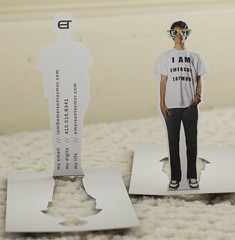 Many people say business cards are becoming obsolete in the age of Google, LinkedIn, Facebook V-Cards and smart phones, though I think the opposite is true. Business cards represent the identity of organizations and individuals, and they create many first physical impressions.
Many people say business cards are becoming obsolete in the age of Google, LinkedIn, Facebook V-Cards and smart phones, though I think the opposite is true. Business cards represent the identity of organizations and individuals, and they create many first physical impressions.
The business-card exchange is one of the most important, galvanizing rituals between two or more people who are likely to engage in some greater social or business interaction. The business card not only is a tangible artifact that creates first impressions, it reinforces second and third impressions when a recipient refers to it for future reference or contact data entry.
Business cards perform basic utility, but they are also accessories that say a lot about you, signals that promote or detract from your company or personal brand. Whether you’re a free agent or an employee, in good economic times or bad, business cards are like oxygen for your ability to do better business.
That’s why I’d like to share a list of business-card best practices, emphasizing elegance, etiquette and practicality. If you adopt these best practices in your organization or free-agent life, I guarantee you’ll experience more meaningful introductions and deeper ongoing relationships.
1. Material and surface. High-quality, tactile paper with rounded corners creates a friendlier and more substantial experience. Rounded corners, as the credit-card industry figured out decades ago, are less likely to catch or slice through people’s skin. Yes, I’ve seen the latter happen.
2. Simple design. Adopt a simple, beautiful design. If you’re not a great designer, hire one. Use light backgrounds, multiple colors, and a beautiful font, and ensure the type is large enough so people with poor eyesight can read it. Business cards are not items to get cheaply. Invest in them the same way you’d invest in a nice business suit.
3. Scanner-compatible. Make sure your business cards are compatible with card scanners. If you want to exist in someone’s life, you’ll have a greater chance of doing so if your contact information can easily be digitized in contact databases. It’s still early, but I imagine cards will soon have smartphone scanner codes that direct card recipients to special landing pages on the Web, or automatically retrieve profile information from the cloud.
4. Personalization. Personalize your card — with a photo, a quote, a graphic or something unique — so it becomes an extension of you — and, preferably, something to talk about. My friend Bruce Ertmann, formerly at Toyota, had a business card that read on the back: “Should the person reading my business card know of anyone not satisfied with our products or services, I will consider it a favor to be notified. Above all things, we wish to avoid having a dissatisfied customer.” That got me talking. I was also impressed by a country-music talent agent whose business card included his signature written in 18-carat gold.
5. Minimalism. Balance personalization with minimalism. For example, omit extraneous information like industry affiliations, certifications and multiple academic degrees, unless they’re really important and highly relevant to your card recipients. Use fewer words, not more, and that includes keeping job titles descriptive yet as short as possible. Don’t include more contact information than your email, office, mobile and physical address. If people really need your fax number, they’ll call you. If people want to follow you on Twitter or connect with you via Skype, they’ll simply look you up online. Lots of white space is not only cleaner, but makes you stand out against the clutter and complexity that are so many other business cards.
6. Readily available. Keep business cards with you, always within reach. These days, with few exceptions, not having business cards makes you look unprepared and unprofessional. Simply, business cards won’t benefit you if you don’t have them.
7. Presentation. Keep your business cards neat. Worse than not having business cards is having poorly kept business cards. Do you think recipients like accepting crinkled, dirty cards that came out of the inner pocket of your old leather wallet or back pocket? No, that’s disgusting and insulting. If you don’t have a purse, murse (“man purse), briefcase or satchel with a dedicated, easily accessible business-card holder, you should invest in a high quality, dedicated card holder, perhaps made of polished metal or high-quality leather. The latter method is ideal because it improves your image in a James Bond kind of way, eliminates fumbling in bags, and accentuates the overall business-card exchange.
8. Grace. Present and accept business cards with grace. I’ve always been horrified by people who celebrate valuable introductions by flinging their cards across conference-room tables, often requiring fallen cards to be fished from the floor.
Conversely, I’ve long admired how the Japanese handle the business-card (or meishi) exchange. According to Wikipedia, the presenter holds the card out with both hands and introduces himself by affiliation, position, and name. The card is held at the bottom two corners using both hands, face up and turned so that it can be read by the person receiving the card. The receiver holds it at the top two corners using both hands, avoiding the placement of one’s fingers over the name or other information. Upon receiving the card, one is expected to read the card over, noting name and rank, then thank the presenter with a bow. A receiver should not write on or place the card in a pocket; the proper procedure is to file the card at the rear of a leather case.
While most Westerners are not fluent in this ritual, adopting even a few of its elements will dramatically increase the quality of any business-card exchange.
Do you have any additional business-card tips that make a difference?
(Photo credit: etaymor)
